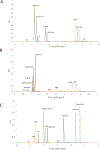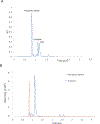Liquid chromatography method for simultaneous quantification of ATP and its degradation products compatible with both UV-Vis and mass spectrometry
- PMID: 35797802
- PMCID: PMC9479163
- DOI: 10.1016/j.jchromb.2022.123351
Liquid chromatography method for simultaneous quantification of ATP and its degradation products compatible with both UV-Vis and mass spectrometry
Abstract
ATP and its degradation products are essential metabolic and signaling molecules. Traditionally, they have been quantified via high-performance liquid chromatography (HPLC) with UV-Vis detection while utilizing phosphate buffer mobile phase, but this approach is incompatible with modern mass detection. The goal of this study was to develop an ultra-performance liquid chromatography (UPLC) method free of phosphate buffer, to allow for analysis of adenine nucleotides with UV-Vis and mass spectrometry (MS) simultaneously. The final conditions used an Acquity HSS T3 premier column with a volatile ammonium acetate buffer to successfully separate and quantify ATP-related analytes in a standard mixture and in extracts from non-contracted and contracted mouse hindlimb muscles. Baseline resolution was achieved with all 10 metabolites, and a lower limit of quantification down to 1 pmol per inject was observed for most metabolites using UV-Vis. Therefore, this method allows for the reliable quantification of adenine nucleotides and their degradation products via UV-Vis and their confirmation and/or identification of unknown peaks via MS.
Keywords: ATP; Adenine nucleotides; Mouse; Muscle; UPLC/MS.
Copyright © 2022 Elsevier B.V. All rights reserved.
Figures







Similar articles
-
[Determination of sixteen antibiotics and four β-agonists in human urine samples using ultra-performance liquid chromatography-tandem mass spectrometry based on high-throughput automatic solid-phase extraction].Se Pu. 2023 May 8;41(5):397-408. doi: 10.3724/SP.J.1123.2022.08025. Se Pu. 2023. PMID: 37087605 Free PMC article. Chinese.
-
[Simultaneous determination of 29 pesticides residues in bayberry by pass-through solid-phase extraction and ultra-performance liquid chromatography-high resolution mass spectrometry].Se Pu. 2021 Jun;39(6):614-623. doi: 10.3724/SP.J.1123.2020.11011. Se Pu. 2021. PMID: 34227322 Free PMC article. Chinese.
-
[Simultaneous determination of 11 prohibited and restricted veterinary drugs and their metabolites in animal-derived foods by ultra performance liquid chromatography-tandem mass spectrometry coupled with solid phase extraction].Se Pu. 2021 Apr 8;39(4):406-414. doi: 10.3724/SP.J.1123.2020.05012. Se Pu. 2021. PMID: 34227761 Free PMC article. Chinese.
-
Analysis of alkaloids in Coptis chinensis Franch by accelerated solvent extraction combined with ultra performance liquid chromatographic analysis with photodiode array and tandem mass spectrometry detections.Anal Chim Acta. 2008 Apr 21;613(2):184-95. doi: 10.1016/j.aca.2008.02.060. Epub 2008 Mar 5. Anal Chim Acta. 2008. PMID: 18395058
-
Forced degradation and impurity profiling: recent trends in analytical perspectives.J Pharm Biomed Anal. 2013 Dec;86:11-35. doi: 10.1016/j.jpba.2013.07.013. Epub 2013 Jul 31. J Pharm Biomed Anal. 2013. PMID: 23969330 Review.
Cited by
-
Intrinsic adaptations in OXPHOS power output and reduced tumorigenicity characterize doxorubicin resistant ovarian cancer cells.Biochim Biophys Acta Bioenerg. 2022 Nov 1;1863(8):148915. doi: 10.1016/j.bbabio.2022.148915. Epub 2022 Sep 2. Biochim Biophys Acta Bioenerg. 2022. PMID: 36058252 Free PMC article.
-
Evaluation of purine-nucleoside degrading ability and in vivo uric acid lowering of Streptococcus thermophilus IDCC 2201, a novel antiuricemia strain.PLoS One. 2024 Feb 22;19(2):e0293378. doi: 10.1371/journal.pone.0293378. eCollection 2024. PLoS One. 2024. PMID: 38386624 Free PMC article.
-
Coordination between the eIF2 kinase GCN2 and p53 signaling supports purine metabolism and the progression of prostate cancer.Sci Signal. 2024 Nov 26;17(864):eadp1375. doi: 10.1126/scisignal.adp1375. Epub 2024 Nov 26. Sci Signal. 2024. PMID: 39591412 Free PMC article.
-
Myoglobin expression improves T-cell metabolism and antitumor effector function.J Immunother Cancer. 2025 Jun 3;13(6):e011503. doi: 10.1136/jitc-2025-011503. J Immunother Cancer. 2025. PMID: 40461159 Free PMC article.
-
Uric acid formation is driven by crosstalk between skeletal muscle and other cell types.JCI Insight. 2024 Jan 23;9(2):e171815. doi: 10.1172/jci.insight.171815. JCI Insight. 2024. PMID: 38032735 Free PMC article.
References
-
- Fox IH (1981). Metabolic basis for disorders of purine nucleotide degradation. Metabolism, 30(6), 616–634. - PubMed
-
- Zielinski J, & Kusy K (2015). Hypoxanthine: a universal metabolic indicator of training status in competitive sports. Exercise and Sport Sciences Reviews, 43(4), 214–221. - PubMed
-
- Brault JJ, & Terjung RL (2001). Purine salvage to adenine nucleotides in different skeletal muscle fiber types. J. Appl. Physiol. 91(1), 231–238. - PubMed
MeSH terms
Substances
Grants and funding
LinkOut - more resources
Full Text Sources

